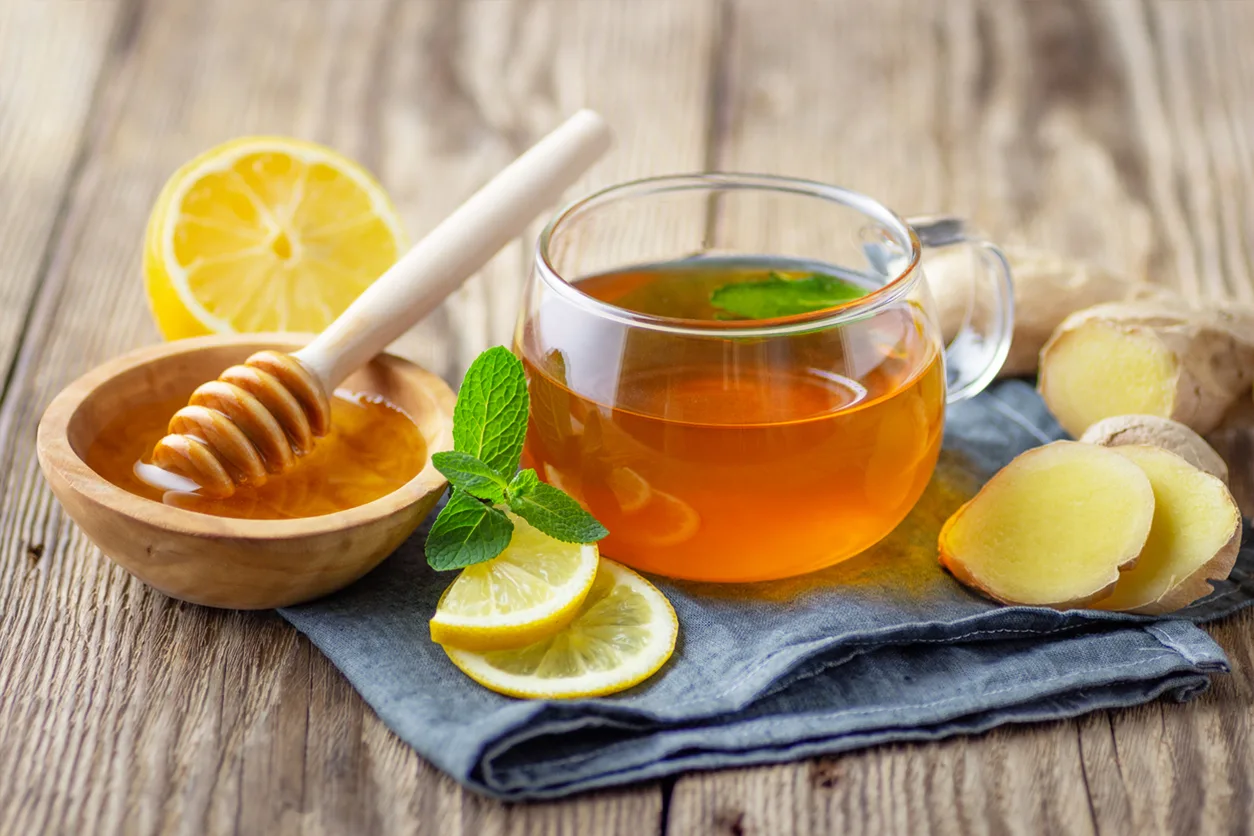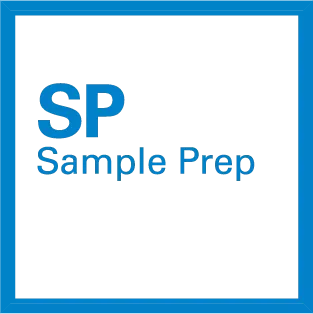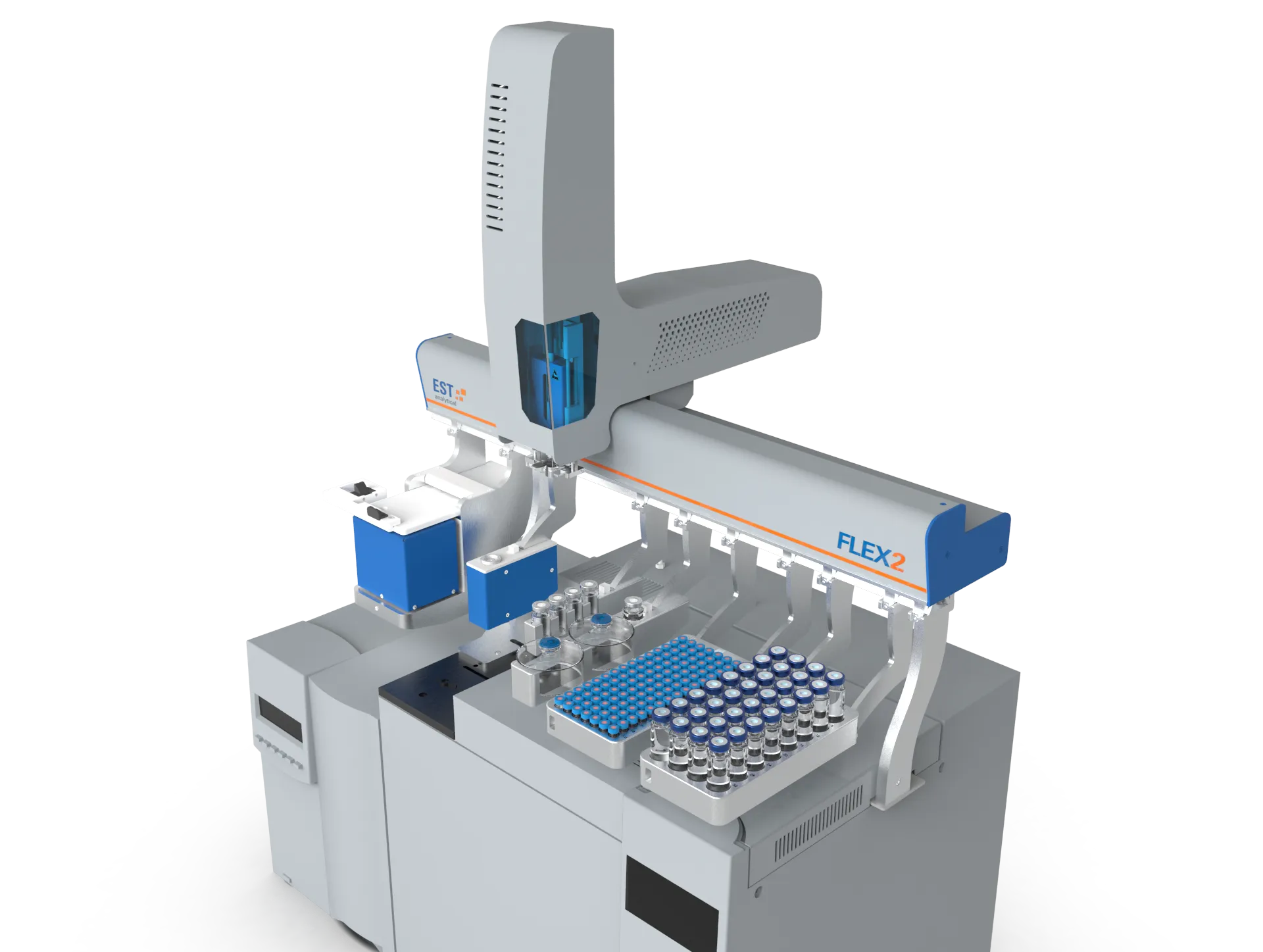Food, Flavor and Consumer Products
Due to the complex nature of food chemistry, a wide variety of techniques are utilized by laboratories for both R&D and quality control.
Sample preparation can be a limiting, tedious and a cause of repetitive motion syndrome in laboratory technicians. The fully programmable Flex 2 autosampler can perform many of these routine tasks, protecting the analyst from injury and toxic solvents while providing improved %RSD and high throughput.
Due to its robustness, Headspace autosamplers such as EST Analytical’s Flex 2, are commonly used to evaluate aroma profiles of manufactured goods and competitors’ products. Since only volatile components are injected in to the GC, non-volatile residues which can cause maintenance issues and instability remain in the vial making headspace is a very robust technique.


The Flex 2’s SPME (Solid Phase Micro Extraction) option is more selective and sensitive that headspace analysis, but can come with its own challenges. Capable of both volatile and semi-volatile analysis, method development decisions include incubation time and temperature, extraction time, chromatographic conditions and most importantly SPME fiber type. Conditions must be very well considered to eliminate possible thermal degradation of target analytes before analysis.
Purge and trap and Dynamic Headspace systems such as the EST Evolution and Centurion, offer automated, very sensitive techniques that can provide trace level, reproducible analysis on a wide variety of matrices. By sweeping and concentrating the volatiles from a given sample onto a trap, PPT levels of volatile compounds can be analyzed.
No matter what your GC application, EST analytical has a wide variety of solutions and application assistance to ensure your success.
SPME
Solid Phase Micro Extraction (SPME) is an extraction process for both volatile and semi volatile compounds in preparation for GC or HPLC analysis. One of the major benefits of SPME is that by choosing the proper extracting phase coated on a SPME fiber, target analytes can be extracted leaving unwanted compounds behind in the matrix. This makes SPME very popular in applications where the resulting chromatograms are complex, with many different types of compounds (See SPME application notes below). Maybe the analyst wants to see polar compounds that are typically related to a foods taste or smell. A polar extraction phase can be chosen to target these compounds, resulting is a simpler, easier chromatogram. Since the extraction uses no solvent, part per trillion (ppt) detection levels are possible and the analyst does not come in contact with potentially dangerous solvents during the analysis.
If you are new to SPME, please reach out to us for recommendations on method parameters and we will be glad to help!

Whitepapers
There are a large variety of volatile compounds that can be found in alcohol. These volatile compounds can add or deter from the flavor of your drink. Trained analysts can often detect the flavors in liquors by smelling and tasting a sample. However, in order to establish the quality and essence of a liquor sample, further testing is required. Gas Chromatography coupled with Mass Spectrometry (GC/MS) is an effective tool for the determination of the flavor compounds in an alcohol. Utilizing different sampling techniques, the respective efficiency in the determination of flavor compounds in whiskey samples will be investigated.
This application note will compare dynamic headspace and Solid Phase Micro Extraction (SPME) sampling techniques for the detection of the volatile components in plain yogurt. Yogurt has been around for years and the health benefits are well known. With the advent of Greek yogurt, there has been increased interest and consumption of yogurt. Yogurt is a very healthy food. It has the nutrients found in milk like calcium, magnesium, potassium and vitamins B-2 and B-12. Furthermore, yogurt has the benefit of containing bacteria that aids in digestion. With all of these benefits, many food companies have increased interest in selling yogurt products. Thus, analysis of yogurt becomes essential for creating a product that will sell.
Tea flavors can vary from spicy to flowery to fruity and any combination thereof. Moreover, the flavor profile of tea can depend on where the tea leaves are grown, the brewing time and temperature, the processing of the tea leaves, and the type of leaf used. Using Head Space Solid Phase Micro Extraction (HS-SPME) sampling in conjunction with Gas Chromatography/Mass Spectrometry (GC/MS) for separation and analysis, assorted teas will be examined for their varied flavor components.
The steeping time of tea can have a profound effect on flavor. Most tea products have a recommended steeping time and temperature. The steeping temperature of the water can vary from “bring water to a rolling boil” to a “very light steam”. While the steeping time can fluctuate from two to five minutes. If a tea is steeped for too long or at too high of a temperature, it can become bitter. However, longer steeping times enhance the health benefits of tea by increasing the amount of flavonoids extracted from the tea. This application will look at the effects of time and temperature on the extraction of tea flavors and flavonoids.
Trichloroanisole (TCA) has an extremely low odor threshold. This compound is primarily responsible for “cork taint” in wines. TCA levels can often be detected by analytical instrumentation but not by consumers and many wines that contain TCA have won awards. TCA does not pose a health risk for anyone who detects a musty odor in their wine. However, the odor of TCA can be off putting and for that reason, wineries prefer to limit consumer exposure to this compound.
Every wine has a distinct aroma profile. The major components in the aroma profiles can be very similar; however it is the subtleties that can make all the difference. The seemingly small components in the aroma profile of a wine can often have a large impact on the overall flavor. There are an enormous variety of wine brands, flavors, etc…This application note will focus on three types of white wine and their respective aroma profiles using Headspace Solid Phase Micro Extraction sampling.
Through use of different stationary phases, the SPME fiber can extract analytes of different polarities and volatilities by simply employing a stationary phase that best suits the needs of the application. Coupling SPME sampling with GC for separation and Mass Spectrometry (MS) for analysis provides an ideal method to discern flavor compounds. This paper will employ SPME in order to investigate the flavor composition of different beers providing an examination of what flavors beers have in common and what sets them apart.
Soaps are made of fats and oils reacted with lye while body washes are primarily made of water and surfactants. Most bar soaps have a pH of around 9 which can be drying while body washes ideally have a pH of about 5.5 which is similar to a person’s skin pH. While soaps and body washes come in an abundance of scents, some people prefer unscented. This application will compare the volatile and semi-volatile components in unscented soap and body wash.
Olive oil has long been the chosen cooking and/or dipping oil in a Mediterranean diet. It has been proven to be a much healthier alternative to other oil options. Olive oils are not defined by the type of olive used as much as by the process by which the oil is made. This application will examine the volatile components of four different types of olive oil using Solid Phase Micro Extraction.
Solid Phase Micro Extraction (SPME) is a non-exhaustive sampling technique. SPME fibers are covered with different coatings of assorted thicknesses in order to extract analytes from the sample matrix. Often the coating and thickness is dependent on the analytes of interest. The ability to automate changing the SPME fibers in a sampling system is invaluable when the analytes of interest are diverse and require varied coatings for the sample extraction. The advantages of automated SPME fiber exchange will be examined in the application.
During cold and flu season, it is very important to consistently wash your hands. If no soap and water are available many people use hand sanitizer. The Centers of Disease Control recommends that hand sanitizer contain at least 60% alcohol (ethanol) in order for the sanitizer to be effective in killing germs. This application will examine the percent alcohol in hand sanitizer samples using Solid Phase Micro Extraction.
Headspace

Due to its ease of use, reliability and robustness, static headspace is the second most used injection technique after liquid injection of GC applications. Used to analyze volatile organic compounds (VOCs) in a wide variety of matrices, static headspace is used in almost every industry. VOCs in complex matrices such as blood, polymer, food and pharmaceuticals can be analyzed while leaving non-volatile components behind.
A sample is placed into a sealed headspace vial, most commonly a 20ml vial, but 10 ml vials are also used. The sample is heated to a predetermined temperature for an incubation time. During this time, VOC compounds cycle out of the matrix and into the headspace. The point at which the rate of migration from the matrix into the headspace equals the rate from the headspace back to the matrix is called equilibrium. It does NOT mean that the concentration of the analyte is equal between the headspace and the matrix. The concentration is determined by what is called the Partitioning Coefficient (K). The higher the partitioning coeffient, the harder it is for that compound to be released by the matrix. Different techniques can be used to change K and increase the concentration in the headspace.
Whitepapers
As grain products begin to age, they oxidize. One of the products of this oxidation is Hexanal. Hexanal contributes to the green, grassy odor in food and can ruin a good morning when breakfast takes on an unpleasant taste. The amount of Hexanal in foods in one indicator of the expiration date. This study will examine the formation of Hexanal over time as cereal ages.
There are a large variety of volatile compounds that can be found in alcohol. These volatile compounds can add or deter from the flavor of your drink. Trained analysts can often detect the flavors in liquors by smelling and tasting a sample. However, in order to establish the quality and essence of a liquor sample, further testing is required. Gas Chromatography coupled with Mass Spectrometry (GC/MS) is an effective tool for the determination of the flavor compounds in an alcohol. Utilizing different sampling techniques, the respective efficiency in the determination of flavor compounds in whiskey samples will be investigated.
Shampoo is composed predominantly of water, surfactant and foaming agents. However, it is usually the fragrance of the shampoo that consumers enjoy that determines what shampoo they would like to purchase. This application will examine the volatile fragrance components of three different shampoos by static headspace sampling.
Acetaldehyde is formed as beer is fermented as it is an intermediate to ethanol. Most beers have low amounts of acetaldehyde and it generally will not affect the taste of the beer as long as concentration levels are low. This application will examine acetaldehyde in six different types of beer using static headspace sampling in conjunction with Gas Chromatography.
Benzene is classified as a Group A, known human carcinogen, by the Environmental Protection Agency. Benzene is commonly used in the manufacturing of detergents, pharmaceuticals, and dyes. Due to its toxicity, manufacturers take precautions to remove the benzene before products are released to the public. Recently, it has been found, that there can be large amounts of Benzene in sunscreen. This application will examine how to test assorted sunscreen products for Benzene using static headspace sampling.
Purge and Trap Dynamic Headspace
Purge and Trap is a type of dynamic headspace extraction of VOC compounds where a purge gas, such as helium or nitrogen, is passed through a sample and the VOCs are carried to a trap to concentrate them. Used globally for environmental and food testing, Purge and trap can easily perform part per trillion levels of detection using GCMS. Dynamic headspace is similar, but typically the purge gas sweeps over the surface of the sample, not through it. This is useful when the sample may components that create foam during the purging process such as detergents or beer.
For food and flavor analysis, the samples need to be sealed in a sample vial as most food and flavor samples are not water, but are liquid matrices or solids. As food and flavors are composed of an assortment of VOCs, purge and trap can optimize the analysis due to it being an exhaustive technique. A wider range of compounds can be analyzed with better sensitivity that static headspace giving a more complete fragrance profile.

Whitepapers
Before the advent of orange juice from concentrate, people would fresh squeeze oranges for their juice. Concentrate helped make orange juice easier to make and increased its popularity. Following concentrate, manufacturers used flash pasteurization and created ready to drink orange juice and again sales increased. Due to disease in the orange groves and the possibility of the crops getting destroyed by frost, the production of orange juice has gotten more expensive. The increase in production costs creates competition within the orange juice industry to create an orange juice that the public will enjoy and increase their consumption. This application will look at the flavor compound abundances of three different brands of orange juice using purge and trap concentration.
This application note will compare dynamic headspace and Solid Phase Micro Extraction (SPME) sampling techniques for the detection of the volatile components in plain yogurt. Yogurt has been around for years and the health benefits are well known. With the advent of Greek yogurt, there has been increased interest and consumption of yogurt. Yogurt is a very healthy food. It has the nutrients found in milk like calcium, magnesium, potassium and vitamins B-2 and B-12. Furthermore, yogurt has the benefit of containing bacteria that aids in digestion. With all of these benefits, many food companies have increased interest in selling yogurt products. Thus, analysis of yogurt becomes essential for creating a product that will sell.
Solid Phase Micro Extraction (SPME) is the most prevalent sampling technique when examining the flavor composition of tea. However, SPME is not a comprehensive sampling technique, thus some of the compounds may not sample as well as others. Purge and Trap, on the other hand, is an exhaustive sampling technique and is commonly used for the detection of volatile components in water. This application note will examine how effective Purge and Trap is for the detection of flavor compounds in tea.
Strong or weak, light or dark, black or with cream; everyone who drinks coffee has a preference. Today, there are not only the choices of what you would like in your coffee, but also how you would like it brewed. This study will analyze four different instant coffee blends for some of their respective flavors using a purge and trap concentrator.
In the past five years, Vaping has become more and more prevalent. People are trying to quit smoking and vaping provides a somewhat healthier alternative. E-cigarettes are composed of a heating element and a small compartment for the vape solution. The vape liquid is heated and inhaled. E-liquid is composed of water, glycerin and propylene glycol. The liquid is then flavored with a large assortment of flavors and can be procured with or without Nicotine. This application note will examine the flavor components in the vape solution and how nicotine can affect the how the vape liquid tastes.
Sample Preparation

Sample preparation is one of the most important steps in analytical chemistry. Preparation can vary from extractions to dilutions to standard preparation. Attention to detail and accuracy are essential. Automation can remove costly errors and improve precision and accuracy while protecting the analyst from repetitive motion injuries and toxic substances.
Quantitative analysis requires not only sample prep but also standard prep. When preparing a calibration curve, the analyst has to follow a recipe in order to ensure standard accuracy. Any error in the standard preparation and the calibration curve will need to be re-prepped and re-run. Thus, valuable time and resources are wasted.
The EST Flex 2 Robotic Sampling Platform is capable of performing standard preparation and liquid/liquid extraction for small volumes. The Flex 2 can be placed on your benchtop for sample prep or installed on top of a GC system for both sample prep and sample analysis automation.
Whitepapers
Coffee is a requirement for many people to start their day. In order to determine the amount of caffeine in coffee, many coffee producers use liquid-liquid extraction. Assorted coffee blends will be extracted for caffeine using an automated liquid-liquid extraction technique with the intention of answering this question.
The American Society for Testing and Materials (ASTM) Method D8028 is a method to determine dissolved gases in water. The method describes calibration and sampling techniques. One of the recommendations is to ensure the sample is sealed in order to safeguard the integrity of the sample. This recommendation is taken from United States Environmental Protection Agency (USEPA) Method 5030C used for the sampling of volatile organic compounds in water. Many environmental labs currently open their dissolved gas samples in order to place them in a headspace vial for sampling and analysis. This application will compare the efficacy of ensuring the sample is sealed versus opening the sample and pouring it into the sample vial for analysis.







